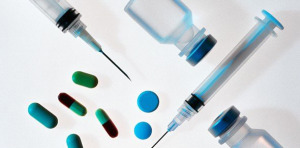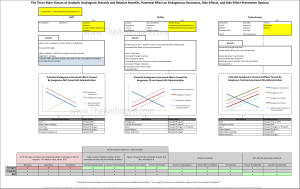Steroids, though illegal for recreational use, hold merit for medicinal purposes via prescription and under the supervision of a doctor. In fact, a lot of research and some of the best compounds available today exist due do medicinal scientist’s attempts to harness all of the muscle building components of AAS, but none of the androgenic “side-effects”. Such drugs have been utilized to stave off muscle wasting in burn victims, those afflicted with cancer or AIDS, and even as potential treatment for those with muscle dystrophy. As a result, scientists developed what they called the “myotrophic–androgenic index” and what bodybuilders and other recreational users of AAS call the “anabolic-androgenic ratio”.

The “androgenic side-effects” is typically the term associated with the development characteristics typical of men, or the “Secondary Sex Characteristics” as labeled by the scientific community. Such traits (and side effects) are as follows:
- Growth of body hair, including underarm, abdominal, chest hair and pubic hair. Loss of scalp hair due to androgenic alopecia can also occur.
- Greater mass of thigh muscles in front of the femur, rather than behind it as is typical in mature females
- Growth of facial hair
- Enlargement of larynx (Adam’s apple) and deepening of voice[3]
- Increased stature; adult males are taller than adult females, on average
- Heavier skull and bone structure
- Increased muscle mass and strength
- Larger hands, feet and nose than women, prepubescent boys, and girls
- Larger bodies
- Square face
- Small waist, but wider than females
- Broadening of shoulders and chest; shoulders wider than hips[4]
- Increased secretions of oil and sweat glands, often causing acne and body odor[3]
- Coarsening or rigidity of skin texture due to less subcutaneous fat
- Higher waist-to-hip ratio than prepubescent or adult females or prepubescent males, on average
- Lower bodyfat percentage than prepubescent or adult females or prepubescent males, on average
- Enlargement (growth) of the penis (during puberty)
These ratios were defined by scientist (Eisenberg and Gordan (1950) via the measured ratio of growth in rats (not humans) of the levator ani muscle (anabolic) versus growth in the seminal vesicles (androgenic). The problem with these studies is that the levator ani muscle is not a skeletal muscle, but is analogous to a human pubococcygeus muscle (PC muscle) which is a hammock-like muscle, found in both sexes, that stretches from the pubic bone to the tail bone and in humans, envelopes the rectum. Other scientists such as (Hershberger),set out to define anabolic androgenic ratios of other compounds but utilized the ventral part of the prostate as a gauge for androgenic activity.
In 1968, Kruskemper (1968) discusses the many failings of the procedures used for determining the myotrophic–androgenic index. For example, the seminal vesicles react much slower to certain androgens, so for tests over short periods of time, data might be skewed towards a higher myotrophic (anabolic) effect vs the androgenic effects.
In the past two decades, scientists still argue on whether or no the levator ani muscle is a fair indicator of skeletal muscle tissue or which part of the prostate should be used to gauge androgenic activity. The takeaway from this reading should be that many of the “anabolic androgenic ratios” we see flying around bodybuilding and steroid forums are the result of numerous rat studies, that differ in the tissues types used to define anabolic vs androgenic activity. In addition, the concentration of androgen receptors may differ in rats vs humans within specific tissue types. Though this is the best and most peer-reviewed information we have, we should take them with a grain of salt. Below is an example of the typical anabolic androgenic ratios you might find floating around on a steroid-related website:
Anadrol 50:
Androgenic/ Anabolic Ratio: 45:320
Anavar:
Anabolic/Androgenic Ratio: 322-630:24
Andriol:
Anabolic/Androgenic Ratio: 100:100
Andropen 275:
Anabolic/Androgenic Ratio:100:100
Deca-Durabolin:
Anabolic/Androgenic Ratio: 125:37
Dianabol:
Anabolic/Androgenic Ratio: 90-210:40-60
Equipoise:
Anabolic/ Androgenic Ratio: 100:50
Halotestin:
Anabolic/Androgenic Ratio:1,900/850
Masteron:
Anabolic/Androgenic Ratio:62:25
NPP:
Androgenic/Anabolic Ratio: 37:125
Oral Turnibol:
Anabolic/ Androgenic Ratio: >100:>0
Parabolan (Tren):
Anabolic/Androgenic Ratio: 500/500
Primobolan:
Anabolic/Androgenic Ratio: 88:44-57
Proviron:
Androgenic: Anabolic Ratio: 30-40/100-150
Testosterone Cyp, Enanthate, Prop, Suspension, and Sustanon
Anabolic/Androgenic ratio:100/100
Winstrol:
Androgenic/Anabolic Ratio: 30:320

